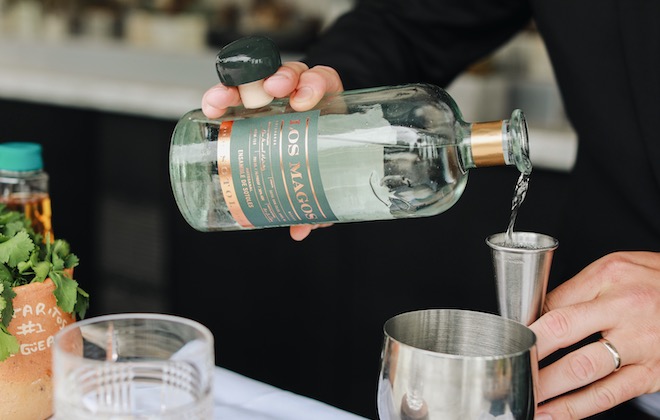Tequila is the second-best selling spirit category in the United States, after vodka. Mezcal is many (many) multiples less than that, but you might not guess as much by how hyped and cherished mezcal is by bartenders, liquor store owners, and the press (and yes, I include myself in that group). Together, the value of sales of tequila and mezcal is higher than that of whiskey. Yet another of Mexico’s traditional spirits is near unheard of: sotol.
Sotol is made from the desert spoon plant rather than agave. The desert spoon grows all over Mexico and the Southwestern United States, and it creates a flowery, easy drinking spirit. Mexico first legalized sotol production in 1994 and subsequently granted it the same designation of origin as tequila and mezcal, meaning that it could legally only be made in the Mexican states of Chihuahua, Durango, and Coahuila. (The U.S., however, does not recognize this designation, which has led to some tension between people in Texas making a desert spoon spirit and calling it sotol).
Part of the reason sotol gets less attention than tequila and mezcal, of course, is access. There are simply much fewer bottles of sotol floating around bars and shops than there are tequila and mezcal. But when you can get your hands on a bottle, sotol is just as easy to love as tequila and mezcal. One of the brands that you can find is Los Magos. I caught up with Los Magos CEO Ryan Stock to learn more about the spirit, what makes it special, and why anyone who is a fan of tequila and mezcal should be seeking out sotol.
This interview has been edited for length and clarity.

Photo: Los Magos
Cool Material: What makes now a good time for consumers to get to know sotol?
Ryan Stock: There is so much noise in the world about spirits these days, especially when talking about Mexican spirits. It’s almost impossible to know what’s “good” with so many similar options available, especially considering that price is no longer an indication of any level of quality. Sotol, specifically Los Magos, is incomparable to what’s currently on the market. Sotol is only produced in a completely organic, natural way, and brings a new, yet approachable and appealing flavor profile. The unique flavor is reminiscent of elements from gin alongside other Mexican spirits.
A versatile blend that works wonderfully whether sipped straight or mixed, Los Magos sotol specifically presents complex notes of citrus, black pepper, light smoke, and eucalyptus on the nose, with a soft and velvety palate that offers flavors of honey and savory spice that ultimately leads to an herbaceous finish. With this being said, sotol is one of the most flexible spirits on the market. Whether sipping the spirit straight or making a distinct cocktail creation such as a Bloody Mary, Espresso Martini, or Negroni, sotol’s unique flavor profile makes it remarkably flexible to work with to the point where it can easily and effectively replace any other spirit in any other cocktail.
How does Los Magos help introduce sotol to people who may be more familiar with other spirits from Mexico?
Sotol has an extremely rich, inspiring history, however, it has only recently gained an increasing popularity here in the States. As we know, mezcal has made an impressive impact on the industry over the past decade or so. This essentially plays a role in how sotol was able to come out as an additional Mexican spirit to live amongst tequila and mezcal (though, these are completely different spirits as sotol is actually made from a sotol plant, NOT agave).
Los Magos was specifically created with two primary goals in mind: to create an approachable and palatable expression of the historic cultural spirit from Northern Mexico to be enjoyed by a wide consumer base, in addition to being recognized as the best premier sotol that paves the way for its kind.

Photo: Los Magos
For those who know nothing about the sotol category, it is important to first understand sotol’s storied background as this helps better understand the spirit itself considering the culture and flavors of its origin, Chihuahua, are extremely present within the spirit. Those trying Los Magos Sotol for the first time will immediately experience the unique earthy flavor profile, comparing its qualities to that of gin and whiskey.
What are the biggest challenges to getting people to understand sotol?
Understandably, consumers instinctively associate Sotol as “another” tequila and or mezcal. We don’t fault consumers for this at all, as there is commonly only one primary spirit that comes out of a specific region and culture. Usually this is directly tied to the natural resources that come from the region, for example Scotch in Scotland, Irish whiskey in Ireland, gin in England, etc. Sotol breaks the mold of what consumers can expect from Mexico as a completely different spirit category that still shares the rich history as it’s agave spirits. Mexican spirits, specifically agave spirits, have predominantly owned the market for the past decade–it’s no wonder that consumers primarily associate Mexican spirits with the beloved agave. It is also important to note that Sotol’s unique flavor brings a new element to the already popular Mexican spirit industry. Introducing Sotol into this market requires a commitment to educating consumers on how and why Sotol is not part of the agave category, but that’s where the great opportunity lies!
Can you explain the process of how Los Magos goes about wild harvesting?
We believe in never taking more than we should. With this being said, we only forage and handpick fully matured plants, prioritizing cutting the plant so that the roots remain and the plant itself is intact to allow for regeneration. The leaves are left behind as offering and nourishment to the ground we take from.
The Sotol plant is wild grown and 100 percent organic from the wild lands of the Chihuahuan grasslands, mountains, and desert, without ever being compromised by fertilizers or crop enhancing technology. The harsh environment requires Sotol to mature significantly longer than it would take if it were in a controlled environment (i.e. being watered regularly). The 15 to 25 year maturing process allows the plant to absorb all the incredible essences from the surroundings.
The result is a bouquet of flavors incomparable to any other spirit around the world. We’ve found that, similar to wine, the region we harvest the wild plant from will dramatically influence the flavor profile of that specific Sotol, and that the wild harvest approach allows us to capture flavors that we would not be able to replicate in a singular, farmed estate environment. You can truly taste the beauty of the harvest in every sip!

Photo: Los Magos
How do you suggest people drink Los Magos?
Unlike most spirits that have a “drink of choice” that is generally the primary cocktail you utilize that spirit for, Los Magos Sotol is beyond versatile. The natural essential oils of the plant allow the spirit to take different forms depending on what it is being mixed with, making it more versatile than any other spirit on the market. While I drink Los Magos all on its own, I’ve enjoyed it in Espresso Martinis, with pineapple, or in a boozier cocktail such as a Negroni or Manhattan.





